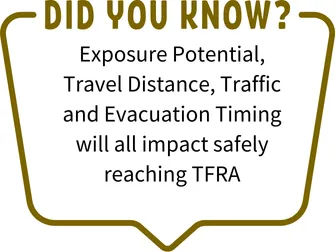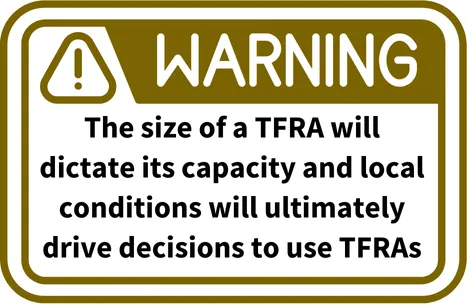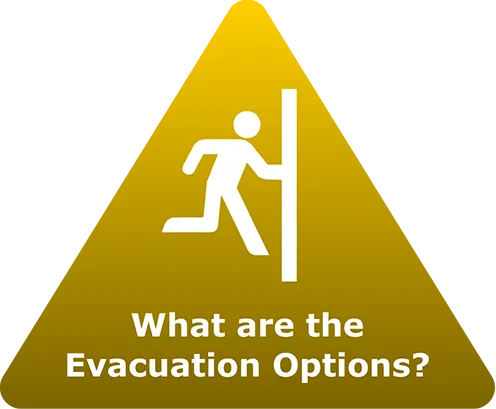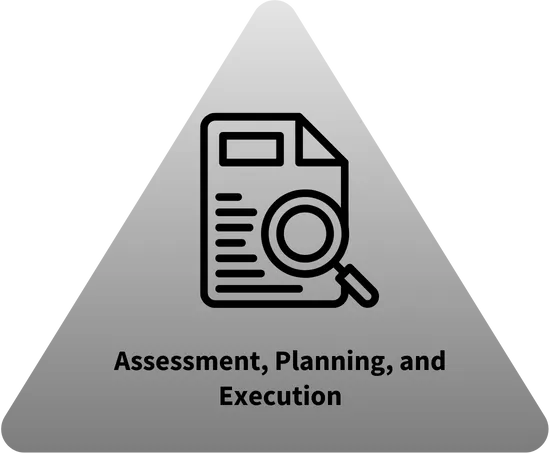
WUI Fire Evacuation and Sheltering Considerations — Assessment Planning and Execution

TEMPORARY FIRE REFUGE AREAS
A Temporary Fire Refuge Area (TFRA) is a pre-identified open space intended to offer reduced exposure to flames and heat when evacuation is no longer possible. Unlike safety zones or formal shelters, TFRAs are not guaranteed safe zones; they are intended only as a last resort. Communities should understand the differences between TFRAs, general TRAs, and safety zones, as well as when and how TFRAs can be used during a fire to save lives under extreme conditions.
What is a TFRA?
A TFRA is a pre-identified and maintained open space location that can provide reduced exposure to flames and heat as compared to the life-threatening exposures encountered in entrapments and burnovers. TFRAs should ONLY be used when evacuation routes are unavailable. Examples of TFRAs include parks, ballfields, parking lots, or cul-de-sacs in your community. A TFRA is not a guarantee of safety — it is a refuge of last resort.
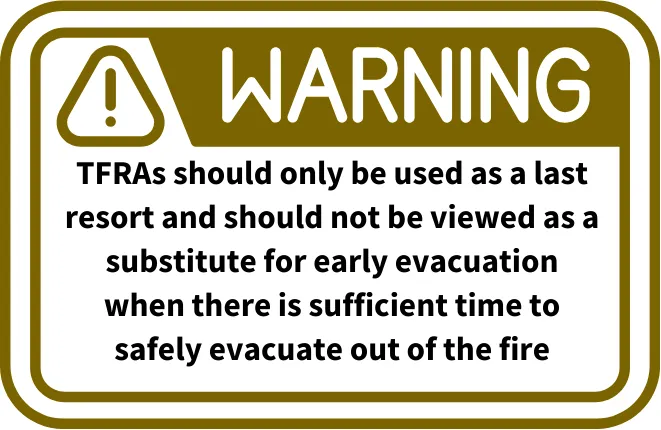
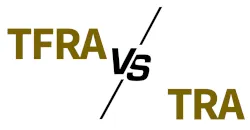
A TFRA is a new approach with a different perspective on the TRA that is utilized by firefighters. A TFRA is an intentionally pre-identified, planned, and maintained location that can be used by the public as a last resort. TRAs are identified by firefighters as part of their contingency operating plans and may be used in an emergency as locations with reduced exposures compared to the surrounding area. A subsequent action will be necessary to relocate to a safer location than the TRA.

Credit: CAL FIRE (top)
This commercial parking lot in Paradise, CA was used as a TRA by approximately 200 civilians during the Camp Fire under the direction of first responders. Existing large areas free of combustibles, such as parking lots, may be suitable as pre-identified TFRAs. To learn more, see A Case Study of the Camp Fire-Notification, Evacuation, Traffic, and Temporary Refuge Areas (NETTRA).

A safety zone is a large open space that provides significant reduction in fire exposures such that the location is tenable without protective equipment. The term "safety zone," given its name, implies a certain degree of protection which may or may not be present in a TFRA. Conceptually, safety zones can be larger that TFRAs to provide "safety" or enhanced protection, however, there are currently no standards for TFRAs or safety zones.

TFRAs are to be used as a last resort. In that context, they should provide a reduced exposure to flames and heat compared to areas outside of the TFRA, but they may not provide the level of protection provided by a safety zone. TFRAs are not a substitute for an early and safe evacuation. The primary goal of a TFRA is to reduce, not eliminate, life safety risks. Conditions at TFRAs will vary based on surrounding fuels and fire behavior, local wind, and size (area) of TFRA. The conditions at a TFRA should not be compared to the safety of a location outside the fire perimeter or to a safety zone, but rather to potential burnover conditions that can occur during evacuations when the fire overtakes egress arteries. TFRAs may be used in wildland and community settings and should account for the potential fire exposures from wildland vegetation and from buildings and other WUI fuels present in the area.
Given the stringent exposure requirements of a safety zone, implementation of true wildfire safety zones is likely improbable. In the event that an area can satisfy the safety zone definition, they should be specifically identified as such. With safety zones being a special exception, TFRAs will be the main focus through the rest of this course.
BENEFITS OF TFRAs
When civilians attempt to evacuate during no-notice events (when there is insufficient time to safely evacuate), fire can overrun egress arteries. Between the combination of fire and traffic gridlock, civilians caught in these conditions have nowhere to go to escape resulting in burnovers and injuries/fatalities. When used during no-notice events in communities where the egress arteries may get compromised, TFRAs can reduce fire exposures to evacuating civilians, thereby enhancing life safety.
USE OF TFRAs DURING A FIRE
The use of TFRAs during WUI fires that rapidly engulf a community reduces exposures to evacuating civilians while simultaneously reducing traffic gridlock. Keeping egress arteries and roadways clear is essential to enable first responders to perform rescue operations. Each TFRA will have a usable core zone that will be able to accommodate a certain number of people based on the area and the anticipated nearby fire exposure sources. As the number of people exceeds the capacity of the core zone, the exposures experienced may increase toward the edge of the TFRA.

IMPLEMENTATION OF A DISTRIBUTED TFRA NETWORK
- There are currently no standards for the design and placement of TFRAs. Ideally TFRAs will be readily available in each neighborhood. Communities will need to leverage existing open spaces to create readily accessible TFRAs.
-
Location/placement considerations for TFRAs:
- The goal is to reduce exposure potential in transit by leveraging existing low exposure potential locations within the community (e.g., parking lots, sports fields, gravel areas).
- A Distributed Wildfire Safety Zone System will reduce exposure potential by reducing transit time from nearby residences.
- Sizing Guidance for TFRAs:
- While there are currently no standards for sizing TFRAs, communities can use the NWCG guidance for safety zones in vegetative fuels as a good starting point for intermix communities. What is not considered in the NWCG guidance are exposures from the built environment (burning buildings, cars, RVs, boats, etc).
- In sizing TFRAs community leaders and first responders must remember that TFRAs are not safety zones. The primary goal of TFRAs is to reduce life safety risks compared to burnover situations.
- Size and location type for the TFRAs used during the Camp Fire. Over 2000 residents were directed to use these TFRAs to reduce exposures and enhance life safety. Learn more...
